It's Time to Take a Look at the Clothes
I've always said that sewing is really about the clothes. It's hard to get excited about sewing technique and easy to be motivated by a rack full of great clothes as you'll see here.
While this page is mostly from the September 2002 edition of the newsletter, it will give you an idea of how the fabrics and pattern silhouettes are ever changing but always classic. If you scroll to the bottom of the page, and click on the next page arrow, you'll see more pictures from a spring issue with appropriate fabrics for that season. All of the outfits that are shown with pants had to have the pants just pinned to my dressform, but you'll certainly get a good idea of how they look.
The details for the conversions and templates to change The Fashion Sewing Group Pattern Collection patterns are offered in each issue of the newsletter as well as other timely fashion information and sewing technique. All of the jacket conversions can be found in the Jackets Workbook, published summer 2005.
I do all of the work on the website and newsletter myself. No staff of website engineers, graphic experts, copywriters, photographers or stylists. Just me. From my sewing machine to the internet. Needless to say, I'm much more confident at the sewing machine. I hope you'll enjoy these inspirations.
Nancy
|

Here's the cover of the September 2002 issue--though these clothes are nearly 5 years old, they're still very wearable in 2007, .
With changes to pants shape or skirt styles, all of the jackets would be as good today as they were then.
To get a lot of sewing done for a season, I stack fabrics, cut them out with a rotary cutter, and then sew similar styles in succession to speed along fit and repetitive technique..
|

Jacket 1945 with the lapel buttoned over with a thread and loop closing
The fabric is a wool and mohair blend that is pintucked.
The pleated pants are of the coordinating solid.
|
|

This is the basic 1945 jacket in a fabric I named Mademoiselle Tweed. It sold out very quickly as it is an interesting classic boucle tweed.
The directions and templates for converting the basic 1945 pattern into this slight v-neck are in the Jackets Workbook.
The directions for using zippers as trim without them working or having the tabs are from September, 2002 and also in the Jackets Workbook.
|

There is an entire chapter on sleeves in the Jackets Workbook to give you a real understanding of jacket pattern shape and technique
Here you see the sleevehead thickened with a bias strip of loosely woven wool.
It's the first step in getting a shapely cap.
|

Even before your sleeve is set into your garment its shape should already be well established.
|

This is the special shoulder pad that I have made just for us. It has a built on cap to keep the sleeve just so without dimpling.
It's placed with the pads holes on the shoulder seam, and the seam of the cap extension even with the armscye seam. It is only tacked to the shoulder seam so there is no pulling or puckering around the armscye.
|
|

Pattern 1962 for the little sleeveless jacket in an Italian alpaca. The top is from 1960 and matches the pants of 1961 in navy blue wool jersey. The pants pattern is very nice made in a knit or lycra blend, either pleated or a flat front version.
|

Pattern 1963 with the hood of pattern 1945C.
This is perfect for the windy city and the hood helps when the snow flies. I have a number of beautiful coatings in stock from a basic black cashmere/wool blend to a coral brushed wool. As always I'm happy to send a swatch, just name a color.
|
|

A shortened car coat length of pattern 1963.
I used a stainless steel clip closure down the front. These particular closures are sold out, but were offered in an issue of the newsletter. Using an innovative closure gives your classics just the kind of fashion edge we like and of course, I have more clips and toggles currently in the collection.
|

The cardigan from pattern 1960 has been converted to a zipper front. Directions are in the September 2002 newsletter.
The pants are from pattern 1961 and made from the coordinating brown wool with the narrow blue pinstripe from that issue.
|
|

Make this in just a couple of hours. The top from pattern 1960 with a matching scarf.
This fabric sold out in a heartbeat--it's a woven boucle with enough stretch to use in the knit only twinset pattern 1960. One subscriber told me she received a swatch of this fabric from another mail order resource, only it was priced more than twice as much.
|
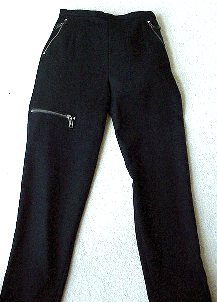
While these now look a bit dated, I think they're a good example of the kinds of things you'll find in the newsletter. If it appears on a runway, I can have it in the newsletter before it's in the stores.
These are the 1961 pants pattern converted into a flat front version with three added zippers for a zippered cargo style that is much more flattering than bulky patch pockets.
|
|
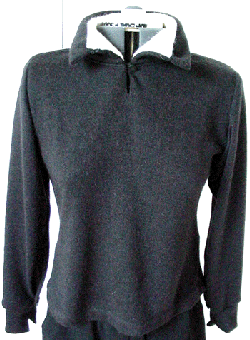
Pattern 1960 again...this time with a double collar.
The Chanel cashmere version was $1650.00.
Directions are in the September 2002 issue. You can purchase back issues. Just email.
|

If you can collar the neckline then make a turn-back cuff for the sleeve too.
|
|

Believe it or not, it's pattern 1960 again.
This is one of the many knit fabrics that are offered in the newslteter and then trimmed with grosgrain ribbon. This is ridiculously easy to make, and is a feminine take on a crew neck. Kinda makes your crewnecks look frumpy now, doesn't it?
|
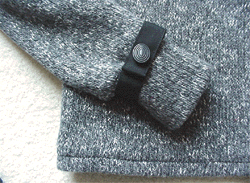
I doubled the grosgrain and edgestitched it. Then did a button treatment.
Complete instructions in the September 2002 back issue.
|
|
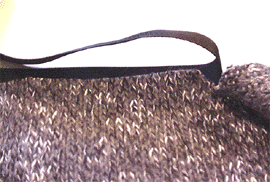
Here you can see how the grosgrain was wrapped under the raw edges.
|

The leaning tower of pantsuit? No, amateur web photographer.
You can cut pattern 1945 a little looser if that's what your figure and/or fashion is up to, or keep it fitted like the original. Isn't it hard to believe that both this jacket and the red tweed with the zipper piping are both from the same pattern?
|
|
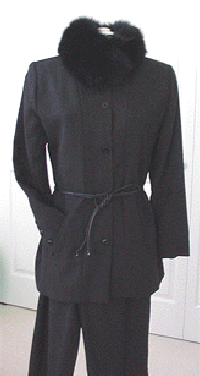
Pattern 1945C with pants pattern 1961.
A simple wool crepe pantsuit was given some glamour by adding a removable black fox collar and tie belt. If you make something really basic and classic like this, it can really be changed from season to season with just a change of accessories.
|

I tried a new collar on the 1945A pattern add-on jacket front. Look for this in the SewImagination Jackets Workbook.
|

Pattern 1960 in it's original state.
It's amazing how I forget how good the basics are...I could live in this twinset.
|

Pattern 1960 top with a detachable cowl.
You can order this knit in the color shown--a brown merlot color, or camel. The pants are 1961 in the pleated version. This sort of casual chic is perfect for a home dinner party.
|
|
|




